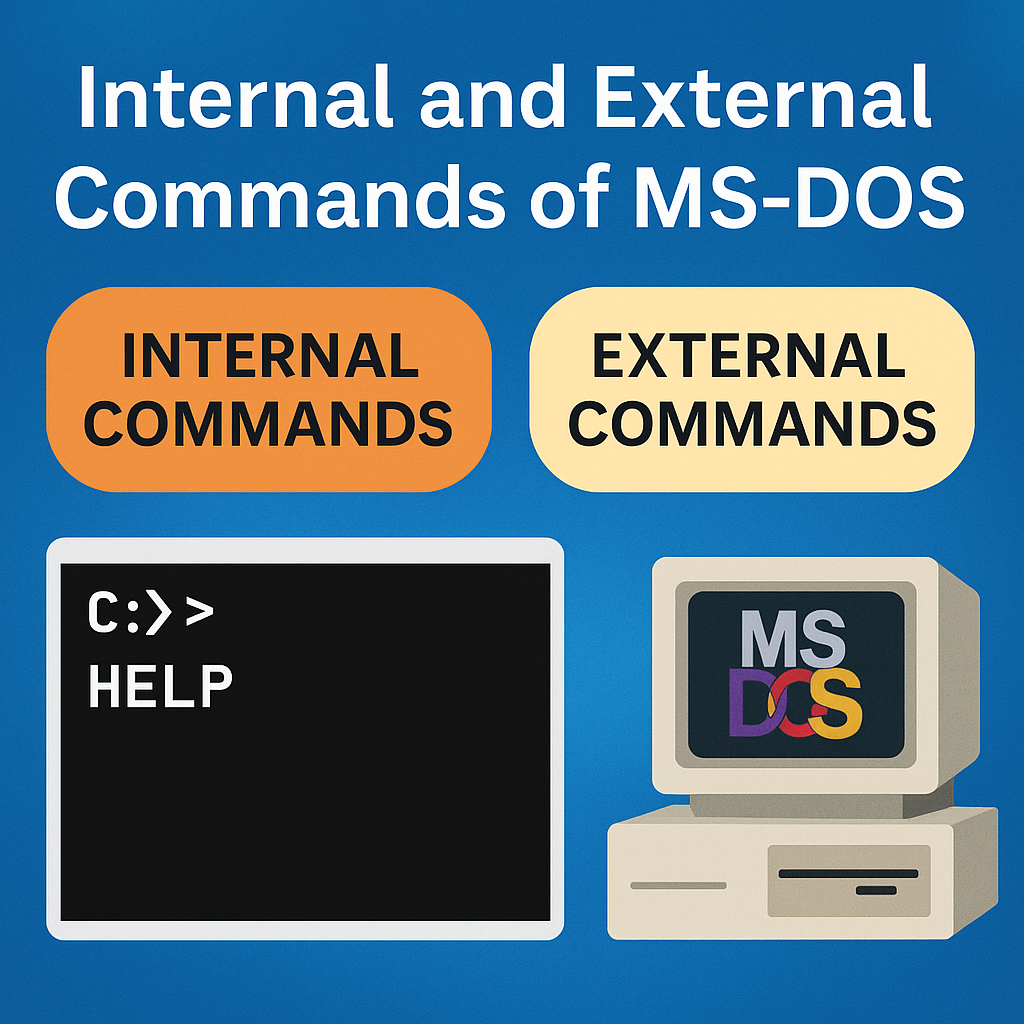Introduction to MS-DOS Commands

MS-DOS (Microsoft Disk Operating System) is a text-based operating system that was widely used before Windows became popular. Even today, understanding MS-DOS is essential for computer fundamentals, especially for students in India and across the globe.
One of the most common topics students encounter is the difference between Internal and External Commands of MS-DOS. In this article, we will cover this topic deeply, with clear definitions, examples, tables, and simple explanations.
What are MS-DOS Commands?
MS-DOS commands are instructions you type into the command prompt to perform specific tasks such as creating files, navigating folders, copying data, or even formatting a disk.
These commands are divided into two main types:
- Internal Commands
- External Commands
Understanding the difference between them is important because they behave differently and are stored differently on your system.
Internal Commands: Definition & Examples
Definition:
Internal commands are built into the command.com file of the MS-DOS operating system. When your system boots up, these commands are automatically loaded into memory. That means you can use internal commands even without accessing any external file
Key Characteristics:
Loaded into memory during system boot
Faster to execute
Available at all times
Do not require any external file
List of Common Internal Commands:
Command Function
DIR Displays list of files and folders
COPY Copies files from one location to another
DEL Deletes files
CD Changes the directory
CLS Clears the screen
TYPE Displays content of a text file
REN Renames a file
VER Shows DOS version
DATE Displays or changes the date
TIME Displays or changes the time
Examples:
DIR: To list files in a folder
CD STUDY: To move into the STUDY folder
DEL NOTES.TXT: To delete the file named NOTES.TXT
External Commands: Definition & Examples
Definition:
External commands are not loaded into memory automatically. These are separate program files (usually with .exe, .com, or .bat extensions) stored on the hard disk or bootable media like a pen drive or floppy disk. You can use them only if the required files are present.
Key Characteristics:
Stored on disk, not in memory
Slower than internal commands
Require external program files
Used for more advanced or larger tasks
List of Common External Commands:
| Command | File Type | Function |
| FORMAT | .EXE | Formats a disk |
| DISKCOPY | .EXE | Copies entire disk to another |
| XCOPY | .EXE | Copies folders and subfolders |
| TREE | .COM | Displays folder structure graphically |
| CHKDSK | .EXE | Checks disk status |
| LABEL | .EXE | Changes disk label |
| SYS | .COM | Transfers system files |
Examples:
FORMAT A: – To format a floppy disk
XCOPY C:\DATA D:\BACKUP /S – To copy entire folder structure
CHKDSK – To check disk health
Key Differences Between Internal and External Commands
| Feature | Internal Commands | External Commands |
| Stored in | Command.com (memory) | Separate files on disk |
| Load Time | Loaded at boot time | Loaded when called |
|
Execution Speed |
Faster | Slightly slower |
| File Dependency | No external file needed | Needs .EXE/.COM/.BAT file |
|
Example Command |
DIR, COPY, CD, DEL |
FORMAT, XCOPY, CHKDSK |
| Availability | Always available | Only if file is present |
Conclusion
MS-DOS may be old, but its command structure teaches the foundation of all modern operating systems. The difference between internal and external commands is simple but powerful. Once you master this, you’ll easily understand how command-line systems work.
Whether you are a student in India or anywhere else in the world, this guide is your complete answer key.
Stay curious, keep learning!
FAQs
Q1. What is an internal command in MS-DOS?
Ans: A command built into the command.com file and available at all times without needing any external file.
Q2. Is FORMAT an internal command?
Ans: No, FORMAT is an external command as it needs format.com to run.
Q3. Where are external command files stored?
Ans: Usually in the C:\DOS or system path folder.
Q4. What happens if an external command file is missing?
Ans: You will get the error: “Bad command or file name.”
Q5. How many internal commands are there?
Ans: There is no fixed number, but commonly around 15-20 depending on the version of MS-DOS.

Leave a Reply